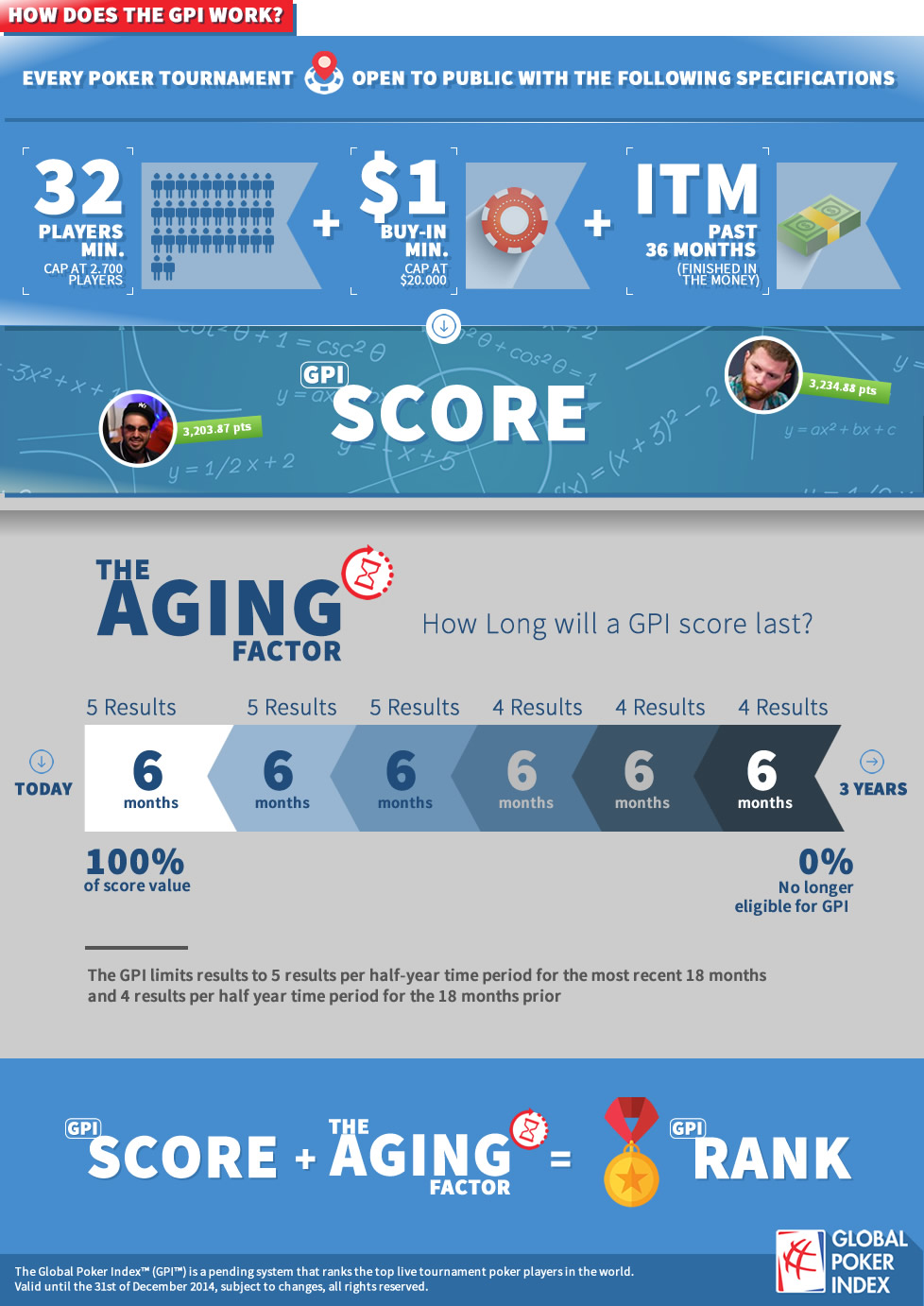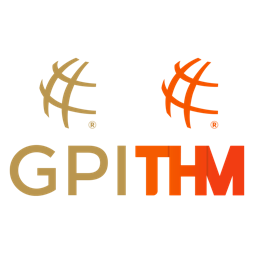ABOUT THE GLOBAL POKER INDEX

click here for details about the GPI Player of the Year rankings
Global Poker Index (GPI): A System for Ranking the World’s Best Poker Players
GPI: The Details
The Global Poker Index (“GPI”) is a ranking of the live tournament poker players in the world as of the day it is published. Players are ranked weekly based on their performance by finishing in cash positions in qualifying tournaments occurring over the previous 36 month period. A cash position is any position where the player receives a portion of the total prize for their performance in an event (all references to buy-in are inclusive of entry fees). Typically the top 10% to 20% of the participants in an event finish in a cash position. Players may only receive one score per tournament. If a player cashes multiple times in the same tournament their score will be based on their highest finishing position. Qualifying tournaments are events with 32 or more players and a buy-in of $1 USD (or other currency equivalent) or higher that are open to the public, and are not specialty or selected audience events such as charity, seniors, doubles, satellite, women, team, employee, executive and CEO events.
Players are ranked according to their finishing scores in qualifying tournaments. Each player’s individual GPI score is an aggregate of scores in events over the previous 36 month period, measured from the day the GPI is calculated. The score for a given event is derived from a combination of their finishing place percentage, buy-in and aging factor. Finishing percentage refers to the percentage of the starting field a player bests in his or her finish. Buy-in refers to the relative amount of the event buy-in to the baseline buy-in of $1000 USD (events with buy-in below $1000 are still compared relative to a baseline of $1000). Aging factor refers to the weighting of results by their recency, where more recent results are weighted more heavily than past results. The GPI limits results to five (5) results per half-year time period for the most recent 18 months and four (4) results per half-year period for the prior 18 months for a maximum total of 27 scores per 36 month aggregation period.
Finishing Percentage Factor
The GPI uniquely takes into account finishing place relative to total field size for an event. The GPI finishing score is expressed as the finishing position relative to field size of the tournament. The base finishing score is calculated as the percentage of the field that is bested by a given player. This means that the relative percentage change in base finishing score between any two places is different depending on number of entrants. The higher the number of entrants in an event, the smaller the percentage change between the base scores for, as an example, a first and second place finish. The lower the number of entrants for an event, the larger the percentage change in base score between a first and second place finish, or any other places in comparison to each other.
A field size cap is applied at roughly the 99th percentile of qualifying events to ensure that events with extremely large field sizes do not skew the overall GPI score. For any event with a field size larger than the field size cap, the field size cap is used to calculate the score rather than the actual field size number. Administration to determine the cap on field size is performed one time per year. The field size cap for 2014 is set at 2,700.,
Buy-in factor
The next factor used in creating an individual event score is based on the buy-in for the event relative to the baseline buy-in for events, $1000 USD, while still allowing events with buy-ins as low as $1 USD. This factor addresses the concept of relative difficulty for the event. Larger buy-in events presume that the difficulty of the field is greater because more elite players enter higher buy-in events.
The GPI takes into account the concept of diminishing returns on the buy-in to an event. The percentage increase in buy-in between a $1500 and $2000 event is much greater than the increase between a $19,000 and a $19,500 buy-in. The GPI seeks to capture this concept of diminishing returns by using a logarithmic function.
A buy-in cap is applied at roughly the 99th percentile of qualifying events to ensure extremely high buy-in events do not skew the overall GPI score. For any event with a buy-in larger than the buy-in cap, the buy-in cap is used to calculate the score rather than the actual buy-in amount. Administration to determine the cap on buy-ins is performed one time per year. The buy-in cap as of 2017 is set at $20,000 USD.
Aging Factor
The final factor used in calculating an individual event score is based on the age of the event, rewarding recent achievements while also allowing contribution for results over the 36-month period. Recent results are weighted more heavily since the GPI seeks to determine who the best live tournament poker player in the world is today. Best is defined by both consistency over time, which is why the ranking system looks over a 36-month period, and recent outstanding performance, which is why more recent results are weighted more heavily.
The GPI separates all results for a player into six distinct half year periods. Based on which half year period an individual result occurred in, the appropriate period-specific aging factor is applied. The aging factor is decreased for each half year period, giving more weight to recent events.
In the event a leap year occurs with the 36 month period, an additional day is applied to the smaller of the two half year periods in the 12 calendar months in which the leap year occurred.
Individual Event Score Calculation
To calculate an individual event score, the GPI program multiplies the Finishing Percentage Factor, the Buy-In Factor, and the Aging Factor. The product of this calculation is the GPI score for the given player in the given event.
Composite Score Calculation
The GPI composite score is the sum of all individual event scores. To help ensure that the GPI overall composite score is not skewed by instances of players performing in extremely large numbers of events, the GPI caps the number of individual event scores for each half year period. The number of events capped for any given half year period is determined by taking the mean number of finishes in live tournaments for the players that are in the GPI. Administration to determine the mean number of finishes is performed annually. Once the mean number of finishes is determined, that is the cap for the number of individual scores that are counted for every half year period. For any player with more individual scores than the cap for the half year period, the highest individual event scores are calculated as part of the composite score, while the lower individual event scores are discarded. These discarded events may be later included in the composite score as they move from one half year period to the next.
GPI Ranking List
After all composite scores are calculated, players are ordinally ranked by their composite scores. The top 300 players are then included in the final GPI Ranking List for that week.
Click here for details about the GPI Player Of the Year rankings
